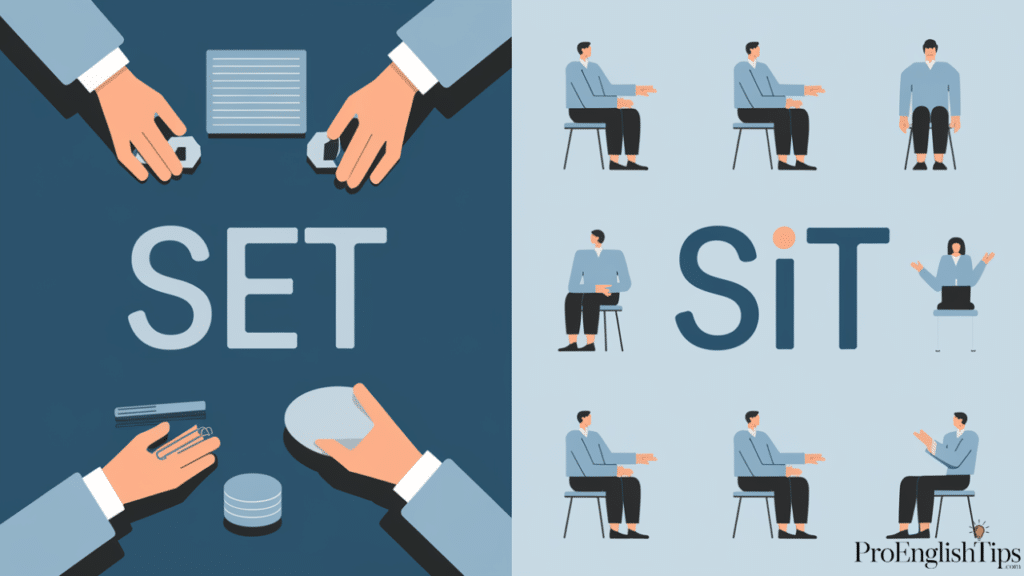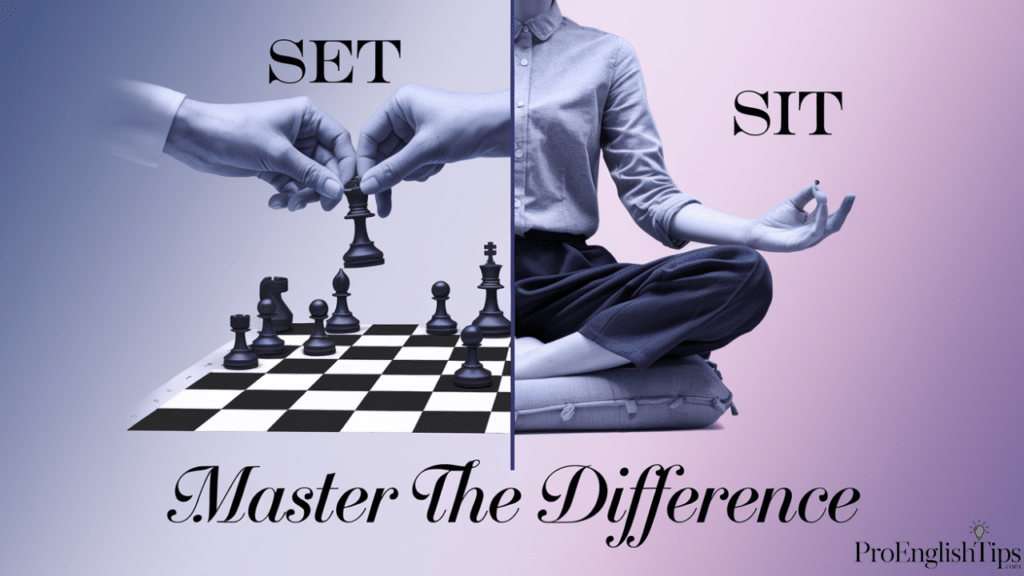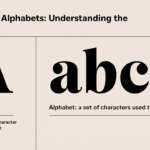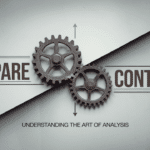English language learners and even native speakers often struggle with the nuanced differences between similar-sounding verbs. The verb comparison between “set” and “sit” presents a fascinating exploration of language mechanics that demands careful attention to grammatical roles and contextual usage.
The Linguistic Landscape of Set and Sit
Understanding the semantic distinction between these two verbs requires a deep dive into their morphological forms and syntactic function. At first glance, “set” and “sit” might seem interchangeable, but linguistic analysis reveals profound differences in their verb properties and application.
Etymology and Origins
The word etymology of “set” and “sit” traces back to different linguistic roots, highlighting their unique language structure. “Set” originates from Old English “settan,” meaning to place, while “sit” derives from Old English “sittan,” indicating a state of resting.

You Might Like: Family’s or Families’ or Families? A Simple Guide
Semantic Context and Classification
Verb classification becomes crucial in understanding their distinct usage patterns. The word disambiguation process reveals that “set” typically involves placing something, while “sit” describes the action of assuming a seated position.

Grammatical Mechanics of Set
| Verb Form | Present | Past | Past Participle | Example Sentence |
|---|---|---|---|---|
| Set | Set | Set | Set | Emily set the book on the table. |
| Set | Set | Set | Set | The photographer set up the camera carefully. |
| Set | Set | Set | Set | They set the alarm for early morning. |
| Set | Set | Set | Set | Sarah will set the dinner plates tonight. |
| Set | Set | Set | Set | The team set new performance records. |
| Set | Set | Set | Set | He set his goals high this year. |
| Set | Set | Set | Set | The sun set behind the mountains. |
| Set | Set | Set | Set | We set the meeting for next Tuesday. |
| Set | Set | Set | Set | The carpenter set the window frame. |
| Set | Set | Set | Set | They set the rules for the competition. |
Transitive Verb Dynamics
“Set” functions primarily as a transitive verb, meaning it requires a direct object. In professional communication, understanding this verb transition becomes essential. Consider an email scenario:
Dear Mark,
I set the project timeline for next quarter. Could you confirm the details?
Best regards, Jennifer
Grammatical Intricacies of Sit
| Verb Form | Present | Past | Past Participle | Example Sentence |
|---|---|---|---|---|
| Sit | Sit | Sat | Sat | Michael sits in the conference room. |
| Sit | Sit | Sat | Sat | The dog sits patiently by the door. |
| Sit | Sit | Sat | Sat | Students sit quietly during the exam. |
| Sit | Sit | Sat | Sat | She will sit near the window. |
| Sit | Sit | Sat | Sat | They sit together during lunch break. |
| Sit | Sit | Sat | Sat | The jury sits to deliberate. |
| Sit | Sit | Sat | Sat | Grandma likes to sit in her favorite chair. |
| Sit | Sit | Sat | Sat | The committee members sit around the table. |
| Sit | Sit | Sat | Sat | Birds sit on telephone wires. |
| Sit | Sit | Sat | Sat | Children sit cross-legged during storytime. |
Intransitive Verb Characteristics
“Sit” operates primarily as an intransitive verb, typically not requiring a direct object. Its verb tense patterns demonstrate remarkable consistency across various contexts.
Practical Language Usage Guidelines
| Scenario | Correct Usage | Incorrect Usage | Explanation |
|---|---|---|---|
| Setting a Table | Sarah will set the plates. | Sarah will sit the plates. | “Set” implies placing objects |
| Taking a Seat | Michael sits in the chair. | Michael sets in the chair. | “Sit” describes body positioning |
| Placing Objects | The carpenter set the window frame. | The carpenter sat the window frame. | Transitive vs. intransitive usage |
| Meeting Arrangement | We set the meeting for Tuesday. | We sit the meeting for Tuesday. | “Set” indicates scheduling |
| Photography Setup | The photographer set up the camera. | The photographer sat up the camera. | Action of positioning |
| Sunset Observation | The sun set behind mountains. | The sun sat behind mountains. | Natural phenomenon description |
| Bird Positioning | Birds sit on telephone wires. | Birds set on telephone wires. | Resting/perching action |
| Goal Establishment | They set ambitious goals. | They sit ambitious goals. | Creating or establishing |
| Time Indication | The clock is set to 7 PM. | The clock is sit to 7 PM. | Configuring time |
| Test Environment | Students sit for the examination. | Students set for the examination. | Participating in an activity |
Advanced Language Precision
Writing proficiency demands understanding these subtle verb distinctions. Professional writers and communicators must internalize these language mechanics to achieve remarkable writing accuracy.
Contextual Considerations
The semantic context of each verb shifts dramatically depending on the situation. A business email might use “set” to establish parameters, while a casual conversation might involve “sit” to describe physical positioning.
Writing Style and Verb Choice
Mastering verb choice represents a critical component of language clarity. By understanding the nuanced differences between “set” and “sit,” writers can elevate their writing style and communicate with precision.
Professional Communication Insights
| Communication Type | Preferred Verb | Reasoning |
|---|---|---|
| Technical Reports | Set | Implies precise placement |
| Casual Conversations | Sit | Describes physical positioning |
| Academic Writing | Set | Suggests establishing parameters |
| Creative Writing | Varies | Depends on narrative context |
| Business Emails | Set | Indicates action and arrangement |
| Personal Letters | Sit | Describes relational positioning |
Language Mastery
Word distinction represents more than grammatical nitpicking—it’s about language proficiency. By embracing these verb usage nuances, communicators can transform their linguistic capabilities.
Recommended resources for continued learning include comprehensive grammar guides and linguistic analysis texts that explore verb application in depth.
Idiomatic Expressions and Unique Contexts
Language often introduces fascinating exceptions that challenge straightforward verb usage rules. Idiomatic expressions reveal the true complexity of language structure and demonstrate how semantic context can dramatically alter verb application.
Unexpected Verb Transformations
Some scenarios blur the lines between “set” and “sit,” creating intriguing linguistic analysis opportunities. For instance, consider the phrase “The hen sets on her eggs” – here, “set” takes on a biological positioning typically associated with “sit.”
| Idiomatic Expression | Verb Used | Semantic Interpretation |
|---|---|---|
| Set sail | Set | Initiating a journey |
| Sit tight | Sit | Remain patient |
| Set the stage | Set | Prepare an environment |
| Sit on a decision | Sit | Delay making a choice |
| Set in stone | Set | Become permanent |
| Sit through a lecture | Sit | Endure passively |
| Set apart | Set | Distinguish uniquely |
| Sit for an exam | Sit | Participate formally |
| Set free | Set | Release from constraint |
| Sit on the fence | Sit | Remain undecided |
| Set aside | Set | Reserve or postpone |
| Sit out | Sit | Deliberately not participate |
| Set back | Set | Delay or impede |
| Sit in | Sit | Substitute or observe |
| Set up | Set | Establish or prepare |
Grammatical Complexity in Academic Writing
Verb tenses and grammatical roles become particularly intricate in academic and professional contexts. Scholars and researchers must navigate these verb properties with exceptional precision.
Scientific and Technical Writing Considerations
In technical documentation, the choice between “set” and “sit” can significantly impact writing accuracy. A research paper describing experimental conditions might use “set” to indicate precise positioning, while a behavioral study might employ “sit” to describe participant interactions.
Cross-Linguistic Verb Challenges

Word disambiguation becomes even more complex when examining verb classification across different languages. English learners often struggle with these nuanced distinctions, revealing the intricate nature of language mechanics.
| Language | Similar Verb Concept | Linguistic Challenge |
|---|---|---|
| Spanish | Poner (set) / Sentar (sit) | Direct translation difficulties |
| French | Mettre (set) / S’asseoir (sit) | Reflexive verb complications |
| German | Setzen (set/sit) | Single verb covering multiple contexts |
| Russian | Ставить (set) / Сидеть (sit) | Complex grammatical structures |
| Japanese | 置く (set) / 座る (sit) | Cultural positioning nuances |
Technological and Digital Language Evolution
Word etymology continues to evolve with technological advancements. Digital interfaces introduce new usage patterns that challenge traditional verb transition understanding.
API and Programming Contexts
In programming languages, “set” frequently appears as a method for establishing values, while “sit” remains primarily a linguistic construct. This demonstrates how language usage adapts to technological communication needs.
# Programming example of verb usage
def set_configuration(parameter):
"""Sets a specific configuration value"""
system.configuration = parameter
def sit_and_wait():
"""Metaphorical method representing passive waiting"""
while not condition_met:
time.sleep(1)
Psychological and Cognitive Linguistics
Semantic distinction extends beyond grammatical rules, touching on deeper psychological processes of language structure and communication.
Cognitive Processing of Verbs
Neurological research suggests that different verb types activate distinct brain regions, highlighting the profound linguistic analysis underlying seemingly simple language choices.
Writing Proficiency Strategies
Developing writing skills requires more than memorizing rules—it demands an intuitive understanding of verb differentiation and contextual usage.
| Writing Strategy | Purpose | Verb Consideration |
|---|---|---|
| Contextual Awareness | Understand nuanced meanings | Choose between set/sit |
| Active Reading | Observe professional usage | Learn sophisticated applications |
| Systematic Practice | Develop linguistic intuition | Master verb transitions |
| Comparative Analysis | Explore linguistic variations | Understand cultural adaptations |
| Professional Feedback | Refine communication skills | Improve verb selection |
Regional and Dialectical Variations
Language usage demonstrates remarkable flexibility across different English-speaking regions. The semantic context of “set” and “sit” can subtly shift depending on geographical and cultural linguistic patterns.
North American English Nuances
In North American English, speakers often display more fluid verb transition patterns. For instance, colloquial expressions might bend traditional grammatical rules in ways that fascinate linguists.
| Regional Variation | Standard Usage | Colloquial Adaptation | Linguistic Interpretation |
|---|---|---|---|
| Southern US | Set the table | Set the table | Traditional usage |
| New England | Sit down | Set down | Localized verb substitution |
| Midwest | Set a while | Sit a while | Verbal positioning variation |
| Urban Dialects | Set up shop | Sit down for business | Metaphorical verb application |
| Canadian English | Set the appointment | Sit the appointment | Subtle grammatical variations |
| African American Vernacular | Set right there | Sit right there | Cultural linguistic expression |
| Australian Informal | Set yourself | Sit yourself | Reflexive verb usage |
Neurological and Cognitive Processing
Linguistic analysis reveals fascinating insights into how the human brain processes and distinguishes between verb classification. Cognitive linguists have discovered intricate neural pathways associated with different verb types.
Brain’s Verb Processing Mechanisms
When a person hears or uses “set” or “sit,” multiple brain regions activate simultaneously. The morphological forms trigger complex neural networks responsible for:
| Cognitive Function | Neural Activation | Verb Processing Stage |
|---|---|---|
| Semantic Recognition | Temporal Lobe | Initial meaning interpretation |
| Grammatical Parsing | Broca’s Area | Syntactic structure analysis |
| Motor Visualization | Premotor Cortex | Physical action imagination |
| Contextual Integration | Prefrontal Cortex | Meaning refinement |
| Memory Retrieval | Hippocampus | Previous usage recall |
| Emotional Association | Limbic System | Contextual emotional coloring |
| Language Production | Motor Speech Area | Verbal execution |
Professional Communication Strategies
Writing accuracy demands nuanced understanding of verb distinction. Professional communicators must develop sophisticated strategies for precise verb selection.
Email and Business Communication
Consider these sophisticated strategies for selecting between “set” and “sit” in professional contexts:
| Communication Scenario | Preferred Verb | Reasoning | Linguistic Justification |
|---|---|---|---|
| Meeting Scheduling | Set the meeting | Implies arrangement | Transitive verb usage |
| Conference Participation | Sit in the meeting | Describes attendance | Intransitive positioning |
| Project Timeline | Set the deadline | Establishes parameters | Action-oriented verb |
| Committee Participation | Sit on the committee | Describes membership | Positional representation |
| Technical Documentation | Set the configuration | Indicates precise setup | Technical verb application |
| Legal Proceedings | Sit for the hearing | Describes formal participation | Institutional verb usage |
Technological and Digital Language Evolution
Word etymology continuously adapts to technological advances. Digital interfaces introduce novel usage patterns that challenge traditional linguistic boundaries.
Programming languages and artificial intelligence research provide unique insights into verb classification. The computational approach to language reveals fascinating semantic distinctions.
You Might Like: Since vs Sense: Understanding When to Use Each Word
Cultural and Philosophical Implications
Language structure extends beyond mere grammatical rules, touching profound philosophical questions about communication and meaning.
Linguistic Relativity and Verb Usage
The subtle distinctions between “set” and “sit” reflect deeper cognitive processes of categorization and perception. Philosophers of language argue that such verb properties reveal fundamental ways humans conceptualize action and existence.
Advanced Learning Strategies
Mastering verb usage requires more than memorization—it demands a holistic approach to language mechanics.
| Learning Strategy | Cognitive Approach | Skill Development |
|---|---|---|
| Contextual Immersion | Active language engagement | Intuitive verb selection |
| Comparative Analysis | Cross-linguistic examination | Deeper semantic understanding |
| Practical Application | Real-world communication practice | Verb transition mastery |
| Metacognitive Reflection | Self-aware language processing | Advanced linguistic intuition |
| Interdisciplinary Study | Multiple perspective integration | Comprehensive language skills |
Rapid Reference Guide
The Core Difference
Set is primarily a transitive verb meaning to place or position something, while sit is an intransitive verb describing the act of being seated or resting in a seated position.
Memory Tricks
Quick Differentiation Strategy
| Verb | Key Action | Memory Trigger |
|---|---|---|
| Set | Placing objects | “Set something Down” – both start with S and D |
| Sit | Taking a seated position | “Sit In a chair” – matching S and I |
Practical Tips to Remember
- Object Test: If you can do the action to something, use set.
- You can set a book (object receives action)
- You cannot set yourself (use sit instead)
- Movement Indicator:
- Set implies placing or positioning
- Sit implies remaining in a position
- Professional Communication Rule:
- In formal contexts, set typically means establishing or arranging
- Sit describes physical positioning or participating
Conjugation Quick Reference
| Tense | Set | Sit |
|---|---|---|
| Present | Set | Sit |
| Past | Set | Sat |
| Past Participle | Set | Sat |
Common Mistake Detector
Warning Signals that you might be using the wrong verb:
- If you’re talking about an object’s placement, use set
- If you’re describing a person or animal’s positioning, use sit
Mental Visualization Technique
Imagine a scene:
- Set: Picture deliberately placing something down
- Sit: Picture someone lowering themselves into a chair
Final Pro Tip
When in doubt, ask yourself: “Am I describing an action done TO something (set) or an action of BEING in a position (sit)?”
Concluding Reflections
Language proficiency represents a journey of continuous learning. The subtle dance between “set” and “sit” exemplifies the beautiful complexity of English language mechanics.
By embracing these grammatical concepts, communicators transform mere word selection into an art form of precise, elegant expression.

Emma Carter is an experienced blogger at Pro English Tips. She loves helping people improve their English skills, especially through synonyms and creative language use. With a friendly writing style, Emma makes learning fun and easy for everyone. In her spare time, she enjoys reading and exploring new words, always looking for ways to inspire her readers on their journey to better communication.







